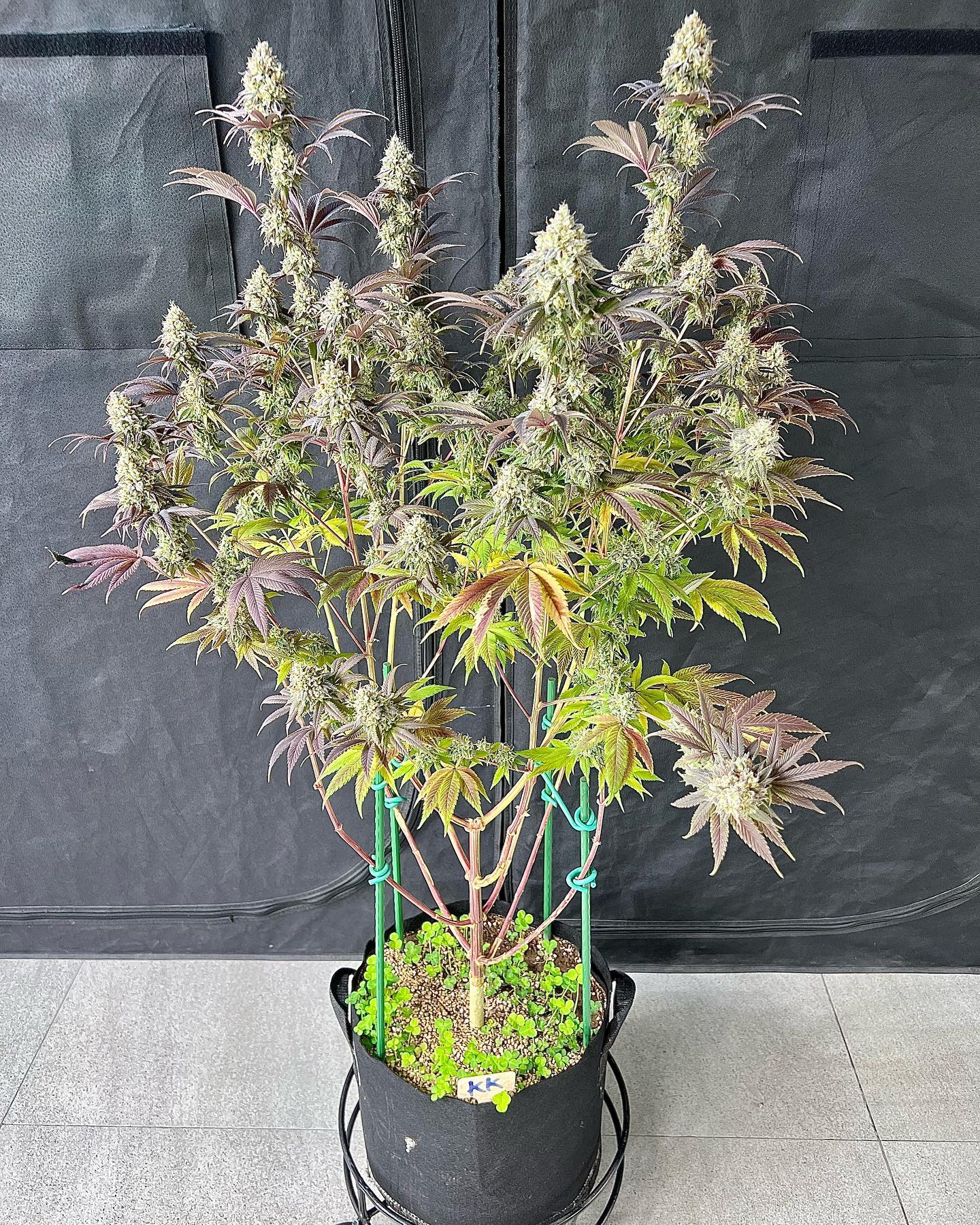Living soil for cannabis: A beginner’s guide

A living soil is one with a healthy community of microbes that work together to break down organic matter within the soil. This then releases valuable nutrients for ongoing growth. Living soil should be rich in the desired bacteria, protozoa, arthropods, nematodes and fungi. One benefit of using living soil is the increased chance of being able to complete the grow without the need for bottled nutrients - simplifying the grow. With correct conditioning the soil can also be re-used several times.
What does growing cannabis in living soil mean?
Growing in living soil is ultimately inspired by the conditions provided in nature. This means all the useful bacteria, fungi and beneficial life forms are present breaking down organic matter into nutrients which are easily absorbed by the cannabis roots.
The indoor cannabis grower goes one step further than mother nature with their living soil by ensuring it is free from pests, gnats, aphids and other grow room undesirables. Those using living soil are often justifiably pleased with the efficiency of their root zone, constantly re-cycling and creating new nutrients sustaining a healthy cannabis root system.
What are the pros and cons of living soil for cannabis?
Pros:
• Living soil can be replenished after use and re-used several times.
• Living soil typically ensures a great taste and aroma on the buds.
• With a sufficiently large grow container of living soil, you may not need to add any bottled (mineral) nutrients since the living soil is constantly creating its own new nutrition.
• Living soil allows fully organic growing without the need for bottled additives. This also means that flushing is rarely advised with living soil.
Cons:
• Living soils are often crafted in smaller quantities by specialist producers. As such a bag of living soil may cost many times that of a standard grow shop soil. Given that most growers get great results from traditional types of grow medium they may feel reluctant to try something new. Especially when it’s expensive.
How is soil food web different from feeding plants nutrients?
Cannabis roots absorb various nutrients so long as pH and temperature are within limits. Hydroponic growers use mineral nutrients. These contain all the main minerals such as Nitrogen, Potassium, Phosphorus etc (as well as minor nutrients) necessary for the cannabis plant to photosynthesise and create new biomass.
Our guide to macro and micro nutrients provides more in-depth info. Hydroponic growers might suffer from blocked pipework if they tried to use anything other than mineral bottled nutrients.
Soil food is different in that it is produced by the fungal/bacterial and various microscopic life forms at work digesting and breaking down organic matter.
This process continuously releases vital micro and macro nutrients into the soil where the cannabis roots absorb them, fuelling plant growth.
What is living soil made of?

Blenders of living soil often regard their craft as a skill that takes years to fully master. Not all of them are happy to reveal the secrets of their success. Living soil uses a diverse range of ingredients which will vary from one supplier to the next. But the following ingredients are often found in various amounts:
• Moss
• Compost
• Peat
• Earthworm castings
• Blood, fish & bone meal
• Bat guano
• Friendly bugs (fungi, bacteria, protozoa, nematodes, arthropods, and sometimes even earthworms)
• Seaweed & extracts of seaweed/kelp
Some specialist companies even add rock dust, dolomite lime or other materials to ensure the plants have a rich source of elements such as Calcium and Magnesium. Ratios of the various ingredients vary from company to company. Many add their own bespoke ingredients such as ground beetle shells, powdered crustacean shells etc.
Many germinate their cannabis seeds directly in the living soil, and some manufacturers recommend this. But it’s worth checking with the living soil supplier, just in case.
Note: When buying a living soil ensure it is in good condition and moist when bought. Generally, you are paying premium prices for living soils, avoid buying any that have e.g. been stored outside in baking heat by negligent stores that fail to understand what a living soil really is.
Organic vs handmade living soil

Most prefer the convenience of buying a living soil from their trusted grow shop/supplier. But some organic growers enjoy making their own. It does require some effort, but the rewards are there with great satisfaction from preparing your own living soil as well as the fun from growing in it.
Be prepared to spend a few hours online looking at recipes from various specialists. And allow a few hours sourcing your ingredients, either online or from local suppliers. If you’re lucky you may be able to collect/grow some of the ingredients yourself.
Living soil vs super soil for cannabis
To many, living soil and super soil refer to the same thing. However, the breeder SubCool also had his own carefully prepared and highly rated ‘Super Soil’ which gained quite a following. This is amended soil with a number of beneficial additives for plant growth and due to the extra nutrient content it may not necessarily be suitable for germinating cannabis seeds and the delicate root systems of younger seedlings.
Does cannabis in living soil need watering?
Yes. regular watering is essential to prevent the living soil drying out and losing the benefit of the carefully curated beneficial bacteria/fungi and other microorganisms that make a living soil so special. Of course, regular watering is essential for your plant needs as well but addition of traditional plant nutrients may not be needed if the grow container is of a sufficient size. That said, many of those that use a living soil will occasionally make their own nutrient tea to replenish and recharge the soil, perhaps in later bloom.
What type of growers is living soil best for?
Less experienced growers might be advised to use traditional, less-expensive grow mediums to begin with. Once the basic grow skills are gained the grower may feel they will get better value from the investment in living soil and less likely to make a rookie mistake with it.
Organic growers are often the most interested in living soil since it offers the grower a pathway that doesn’t require a wide array of supplemental nutrients. Instead the soil itself efficiently provides a self-sustaining root ecosystem which allows vigorous and healthy plant growth without the need for pH meters and EC meters and an increasingly expensive array of bottled nutrients.
Anyone that subscribes to the permaculture ideals, where all waste is recycled to create more produce, will also feel naturally drawn to the concept of living soil for cannabis growing.
What is no-till living soil?

No-till soils are often favoured by outdoor/greenhouse growers who don’t want to dig the land or disturb the soil after each grow. Instead, a cover-crop (nutritious natural organic compost) is often planted after the cannabis has been harvested. This is grown over winter to prevent erosion, suppress weeds and enrich soil fertility once it has been cut down.
Examples of cover crops include cowpea, vetch, rye grass, winter wheat, buckwheat etc. These are often mown and left to rot into the soil proving a green manure without the need to plough or disturb the soil surface.
No-till living soils claim to be free of environmentally damaging additives/amendments such as bat guano - some claim that guano collection disturbs and damages the bat habitats. They are also often free of compost, due to fears of possible pesticide/herbicide/chemical use on some of the composted materials. Blood meal is often not used in a no-till living soil due to fears of hormone/chemical use in the animal feed. Instead, a no-till living soil is blended from specialist recipes of wood, biochar, peat, rice husks, perlite, crab/crustacean shells, kelp, diatomaceous earth, blended mineral dust and fish products.
With such a high-loading of specialist slow-release ingredients a no-till soil should remain rich for many grows/seasons. Advocates of no-till living soil claim the natural grow process produces the best flavours and terpene profiles. They enjoy the traditional approach to farming with a low environmental impact. With naturally rich soil, no additional nutrients need to be used, simplifying the grow and keeping costs low.
Should you start cannabis seeds in living soil?

The answer is yes (usually), you can grow in the living soil from cannabis seed to harvest often without the need for any additional nutrients. You can grow either autoflowering cannabis seeds, feminised seeds or regular seeds in living soil. All will do well.
Check the website of your living soil supplier for tips. They often have useful advice on container sizes, general grow recommendations, seed germination, tea-recipes for feeding (sometimes recommended in bloom), recharging advice to enable soil re-use etc.
Living soil isn’t for everyone. It is expensive and it’s fair to say that only a minority of growers actually use it. But those that do usually claim verdant, vigorous growth and easier grows with their plant naturally staying in the nutrient sweet spot with neither overfeeding nor underfeeding symptoms throughout the grow. That alone gives the grower a wider grow latitude with less chance of grower-error stunting growth and impacting final yield/quality.
If you haven’t considered living soil before, perhaps it’s something that could help you in a future grow.




























